December 12, 2023
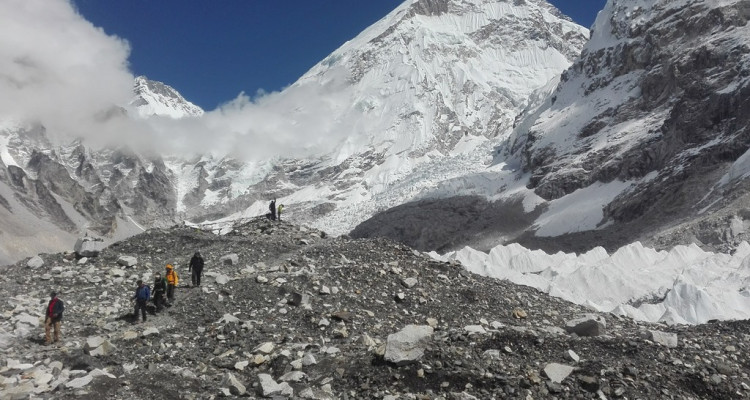
If you’re planning your first trek in Nepal, you might be stuck between two famous choices: Everest Base Camp or Annapurna Circuit. These are the top picks for many trekkers because of their stunning views. Imagine being surrounded by the world’s highest mountains, covered in snow – that’s what both treks offer.
The good news is that both routes have everything you need, especially if it’s your first time doing a multi-day trek in the mountains. Deciding between them, though, is not so simple.
Before my first solo trek in Nepal, I spent a lot of time comparing the advantages and disadvantages of both options. But I know not everyone has the time or patience for that. So, I want to share my experience to help make your decision easier.
Think about it: 12 days Everest Base Camp, with its icy peaks, or Annapurna Circuit, a mix of different landscapes. It’s a tough choice.
As I tell you about my journey, I hope to make it simpler for you to choose between Everest Base Camp and Annapurna Circuit. The Himalayas are calling, and your decision is the first exciting step towards an unforgettable trekking adventure.
Introduction
1.1 Overview of Everest Base Camp
1.2 Overview of Annapurna Circuit
Geography and Scenery
2.1 Landscape of Everest Base Camp
2.2 Landscape of Annapurna Circuit
Trekking Difficulty
3.1 Difficulty Level of Everest Base Camp Trek
3.2 Difficulty Level of Annapurna Circuit Trek
Altitude and Acclimatization
4.1 Altitude Challenges at Everest Base Camp
4.2 Altitude Challenges at Annapurna Circuit
Trekking Routes and Duration
5.1 Route Options for Everest Base Camp
5.2 Route Options for Annapurna Circuit
Teahouse Accommodations
6.1 Teahouse Facilities at Everest Base Camp
6.2 Teahouse Facilities at Annapurna Circuit
Cultural Experience
7.1 Sherpa Culture at Everest Base Camp
7.2 Cultural Diversity along Annapurna Circuit
Breathtaking Views
8.1 Panoramic Views from Everest Base Camp and Kalapathar
8.2 Scenic Views along Annapurna Circuit- Thorung la pass
Flora and Fauna
9.1 Wildlife and Vegetation around Everest Base Camp
9.2 Biodiversity along Annapurna Circuit
Weather Conditions
10.1 Weather Challenges at Everest Base Camp
10.2 Weather Conditions along Annapurna Circuit
Cost of Trekking
11.1 Budget Considerations for Everest Base Camp
11.2 Budget Considerations for Annapurna Circuit
Permit Requirements
12.1 Permits Needed for Everest Base Camp
12.2 Permits Needed for Annapurna Circuit
Crowd Levels
13.1 Crowd Dynamics at Everest Base Camp
13.2 Crowd Levels on the Annapurna Circuit
Best Time to Trek
14.1 Ideal Seasons for Everest Base Camp
14.2 Optimal Timing for Annapurna Circuit
Conclusion
15.1 Choosing Between Everest Base Camp and Annapurna Circuit
15.2 Personal Factors to Consider
1.1 Overview of Everest Base Camp
Everest Base Camp (EBC) is a renowned trekking destination located in the Khumbu region of Nepal. Nestled at an elevation of 5,364 meters (17,598 feet), it serves as the starting point for climbers attempting to summit Mount Everest, the world’s highest peak at 8,848 meters (29,029 feet). The trek to EBC is a challenging yet rewarding adventure, offering breathtaking views of the Himalayan landscape, including iconic peaks like Nuptse, Lhotse, and, of course, Everest itself. The journey to the base camp takes trekkers through picturesque Sherpa villages, suspension bridges, and lush rhododendron forests, providing a cultural and natural experience unlike any other.
The trek typically begins in Lukla, where trekkers embark on a 12-day journey that gradually acclimatizes them to the high-altitude environment. Along the way, teahouses and lodges offer accommodation, and trekkers often interact with the local Sherpa community, gaining insights into their rich culture. Reaching Everest Base Camp is a triumphant moment, allowing trekkers to stand in the shadow of the world’s highest peak and witness the unparalleled beauty of the Khumbu Glacier. The experience is a testament to human perseverance and offers a deep connection to the awe-inspiring grandeur of the Himalayas.
1.2 Overview of Annapurna Circuit trek/Round Annapurna Trek
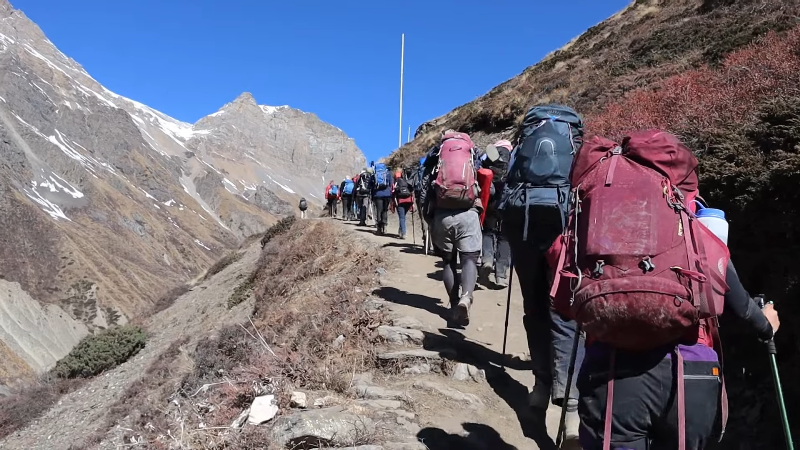
Adventure Annapurna circuit trek/Round Annapurna trekking
The Annapurna Circuit, also known as the Round Annapurna Trek, is a renowned trekking route in the Annapurna region of Nepal, offering a diverse and captivating adventure. This iconic trek takes approximately 15 to 20 days to complete, circumnavigating the Annapurna Massif and providing trekkers with a panoramic view of some of the world’s highest peaks, including Annapurna I (8,091 meters) and Dhaulagiri (8,167 meters). The journey encompasses a variety of landscapes, from subtropical forests and terraced fields to alpine meadows and arid landscapes, showcasing the incredible geographic and cultural diversity of the region.
Commencing in the lowland town of Besisahar, the trail winds through charming villages inhabited by diverse ethnic communities, such as Gurungs and Thakalis. Trekkers traverse the challenging Thorong La Pass at an elevation of 5,416 meters, a high point that provides breathtaking views and a sense of accomplishment. Along the way, trekkers can explore ancient monasteries, interact with locals in traditional teahouses, and soak in natural hot springs for relaxation.
The Annapurna Circuit has evolved over the years, with road construction reducing the length of the trek in some sections. However, the route continues to captivate adventurers seeking a blend of cultural immersion and stunning mountain scenery, making it one of the most cherished trekking experiences in Nepal.
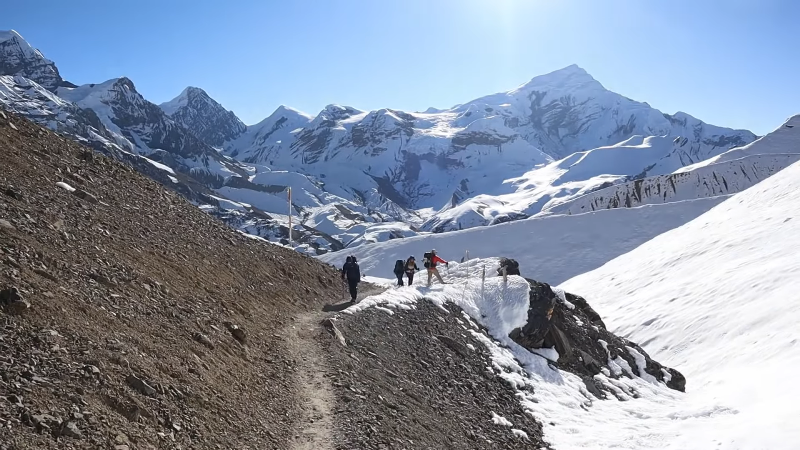
Snowy trail on Annapurna Circuit Trek
2.1 Landscape of Everest Base Camp
The Everest Base Camp (EBC) Trek is renowned for its stunning and diverse landscapes as it takes you through the Khumbu region of Nepal, showcasing the beauty of the Himalayas. The trek typically starts from Lukla and progresses through various villages and landscapes before reaching Everest Base Camp. Here’s an overview of the landscape you can expect during the Everest Base Camp Trek:
Lush Lowland Forests: The trek begins with a flight to Lukla, and from there, you’ll descend through lush, green forests of rhododendron, pine, and fir. The lower elevations are relatively mild, with pleasant temperatures.
Sherpa Villages: As you ascend, you’ll pass through several Sherpa villages, such as Namche Bazaar, Tengboche, and Dingboche. The landscape features traditional Sherpa houses, prayer flags, and Buddhist monasteries, providing a cultural and scenic experience.
River Valleys: The trail follows river valleys, crossing suspension bridges over the Dudh Koshi River. The rivers are fed by glacial meltwater, adding to the picturesque scenery.
Alpine Meadows: Higher up, the landscape transitions to alpine meadows. You’ll see yaks grazing in these areas, and the scenery becomes more rugged as you approach higher altitudes.
Moraines and Glacial Features: The trek takes you close to some of the world’s most famous glaciers, including the Khumbu Glacier. You’ll pass through moraine landscapes, with rocks and debris carried by the glaciers, creating a unique and challenging terrain.
High Mountain Deserts: As you approach Gorak Shep and Everest Base Camp, the landscape becomes more barren and desolate, resembling a high mountain desert. The air becomes thinner, and the views of the surrounding peaks, including Everest, are awe-inspiring.
Snow and Ice: The final stretch to Everest Base Camp involves walking on a mixture of snow and rocky terrain. Depending on the season, you may encounter snow-covered paths, adding to the adventure.
Panoramic Views: Throughout the trek, you’ll be treated to panoramic views of some of the world’s highest peaks, including Everest, Lhotse, Nuptse, Ama Dablam, and many others.
Everest Base Camp: The landscape at Everest Base Camp itself is a mix of rocks, ice, and the imposing Khumbu Icefall. The camp is set against the backdrop of towering peaks, creating an otherworldly environment.
It’s important to note that the weather and terrain can vary based on the season. Spring and autumn are the most popular trekking seasons, offering stable weather conditions and clear skies for the best views.
2.2 Landscape of Annapurna Circuit
The Annapurna Circuit, also known as the Annapurna Round Trek, is another iconic trekking route in Nepal that offers diverse and breathtaking landscapes. This trek takes you through the Annapurna region, showcasing a variety of environments and cultural experiences. Here’s an overview of the landscape you can expect during the Annapurna Circuit:
Tropical Lowlands: The trek often begins in the lowland areas, and you’ll pass through subtropical forests with lush vegetation. You might encounter terraced fields, waterfalls, and small villages inhabited by different ethnic groups.
Cultural Villages: As you ascend, you’ll come across several traditional Nepali villages representing various ethnic communities, including Gurungs, Magars, and Thakalis. The villages are characterized by unique architecture, vibrant local culture, and friendly inhabitants.
River Valleys: The trek involves crossing several river valleys, with numerous suspension bridges spanning the rivers. The Marsyangdi River is a prominent feature, and you’ll follow its course for a significant portion of the trek.
Pine and Rhododendron Forests: The trail takes you through dense forests of pine and rhododendron, especially in the lower to mid-altitude regions. During the spring season, rhododendrons bloom, adding vibrant colors to the landscape.
Alpine Meadows: As you gain altitude, the scenery changes to alpine meadows with yak grazing grounds. The landscape becomes more open, offering stunning views of the surrounding peaks, including Annapurna and Dhaulagiri.
Manang Valley: This is a high-altitude valley that provides a distinct cultural and landscape experience. The villages in the Manang Valley are set against a backdrop of snow-capped peaks, and the terrain becomes more arid.
Thorong La Pass: The highest point of the trek is the Thorong La Pass (5,416 meters or 17,769 feet). The pass offers panoramic views of the Annapurna and Dhaulagiri mountain ranges, and the landscape is rocky and snow-covered.
Muktinath: After crossing Thorong La Pass, the trek descends to Muktinath, a sacred pilgrimage site for Hindus and Buddhists. The landscape around Muktinath includes unique rock formations and a stark, high-altitude desert environment.
Kali Gandaki Gorge: The trek takes you through the Kali Gandaki Gorge, which is the world’s deepest gorge. The views of the surrounding peaks, including Nilgiri and Dhaulagiri, are stunning.
Tatopani Hot Springs: On the descent, you may have the opportunity to relax in the natural hot springs of Tatopani, providing a pleasant break from the trek.
The Annapurna Circuit is known for its varied landscapes, cultural diversity, and the opportunity to witness the different climatic zones as you traverse the circuit. Like the Everest Base Camp Trek, the best times to undertake the Annapurna Circuit Trek/ Annapurna Round Trek are during the spring (March to May) and autumn (September to November) for favorable weather conditions.
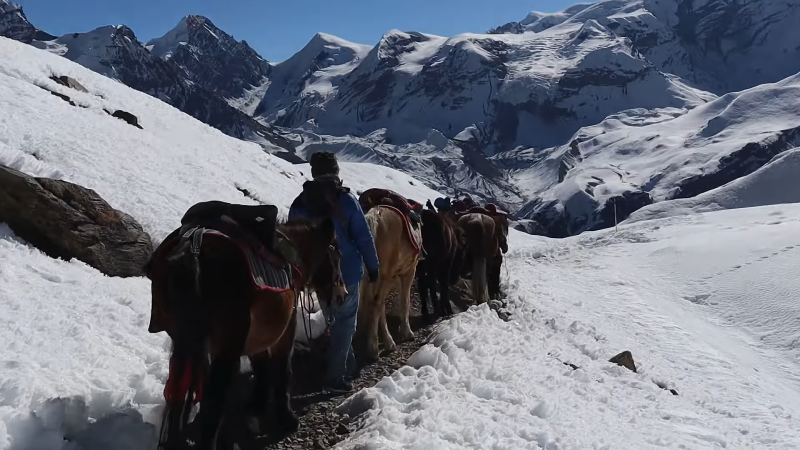
Donkeys Carrying Trekkers luggage
3.1 Difficulty Level of Everest Base Camp Trek
The Everest Base Camp (EBC) trek is considered challenging due to its high altitude and demanding terrain. Trekkers typically start from Lukla, at an elevation of around 2,860 meters (9,383 feet), and ascend to the Everest Base Camp, which stands at 5,364 meters (17,598 feet). The primary challenges include the rapid gain in altitude, exposure to low oxygen levels, and the risk of altitude-related illnesses, such as acute mountain sickness.
The trail involves steep ascents and descents, rocky paths, and occasional exposure to challenging weather conditions, including cold temperatures and the possibility of snow. The duration of the trek, typically around 12 to 14 days, requires a good level of physical fitness and mental stamina. Proper acclimatization is crucial to minimize the risk of altitude sickness. Despite the difficulties, the trek offers stunning views of the Himalayan peaks and a sense of accomplishment upon reaching Everest Base Camp. It is essential for trekkers to be well-prepared, physically and mentally, and to follow safety guidelines to make the journey a rewarding and memorable experience.
3.2 Difficulty Level of Annapurna Circuit Trek
The Annapurna Circuit trek is considered moderately challenging, making it accessible to a wider range of trekkers compared to more strenuous high-altitude treks like Everest Base Camp. The trek usually begins in Besisahar and takes approximately 15 to 20 days to complete, covering a total distance of around 230 kilometers (143 miles). One of the advantages of the Annapurna Circuit is that it provides a more gradual acclimatization process compared to some other high-altitude treks.
The trail encompasses diverse landscapes, including terraced fields, lush forests, picturesque villages, and high mountain deserts. The highest point of the trek is Thorong La Pass, standing at 5,416 meters (17,769 feet). While the altitude is significant, the ascent is more gradual than some other Himalayan treks. Trekkers may encounter challenging sections with steep ascents and descents, rocky paths, and potentially adverse weather conditions, such as snow at higher altitudes. Overall, the Annapurna Circuit is suitable for individuals with a good level of fitness and some trekking experience, offering a rewarding journey through stunning scenery and cultural diversity.

Adventure Annapurna Round Trekking
4.1 Altitude Challenges at Everest Base Camp
Altitude poses significant challenges at Everest Base Camp, located at an elevation of approximately 17,600 feet (5,364 meters). As trekkers ascend through the Khumbu Valley towards the camp, the thinning air becomes a primary concern. Oxygen levels decrease with altitude, leading to a condition known as altitude sickness. Symptoms include headaches, nausea, and fatigue, affecting even the most seasoned climbers. Acclimatization stops are crucial during the ascent, allowing the body time to adjust to the reduced oxygen levels. Trekkers typically spend several days acclimatizing in nearby villages, such as Namche Bazaar, to minimize the risk of altitude-related complications.
In addition to altitude sickness, the harsh weather conditions at Everest Base Camp add to the formidable challenges. The base camp is subject to extreme temperature variations, ranging from scorching daytime temperatures to freezing nights. Unpredictable weather patterns and sudden storms further amplify the difficulty of the trek. Despite the advancements in gear and technology, climbers and trekkers must contend with the harsh reality of Everest’s challenging environment, where preparation and adaptability are crucial for a successful ascent.
Furthermore, the limited availability of medical facilities at Everest Base Camp intensifies the risks associated with altitude-related illnesses. The remote location and challenging terrain make it difficult for immediate evacuation in case of emergencies. Thus, climbers and trekkers must prioritize their health and adhere to a gradual ascent to minimize the impact of altitude on their bodies, ensuring a safer and more successful journey to the iconic Everest Base Camp.
4.2 Altitude Challenges at Annapurna circuit trek
The Annapurna Circuit, a renowned trek in the Himalayas, presents its own set of altitude challenges. Beginning at approximately 2,700 feet (820 meters) and reaching its highest point at Thorong La Pass (17,769 feet or 5,416 meters), trekkers traverse a wide range of elevations. Altitude-related issues, such as acute mountain sickness (AMS), can affect individuals as they ascend rapidly. Adequate acclimatization is crucial, with strategic rest days incorporated into the trek to allow the body to adjust to the decreasing oxygen levels.
Moreover, the weather conditions along the Annapurna Circuit contribute to the altitude challenges. Trekkers encounter diverse climates, from subtropical regions with lush forests to arid, high-altitude deserts. Rapid changes in temperature and occasional snowfall can add an element of unpredictability. Proper gear and preparation become essential, as the combination of varying altitudes and challenging weather conditions demands adaptability from those embarking on this iconic trek.
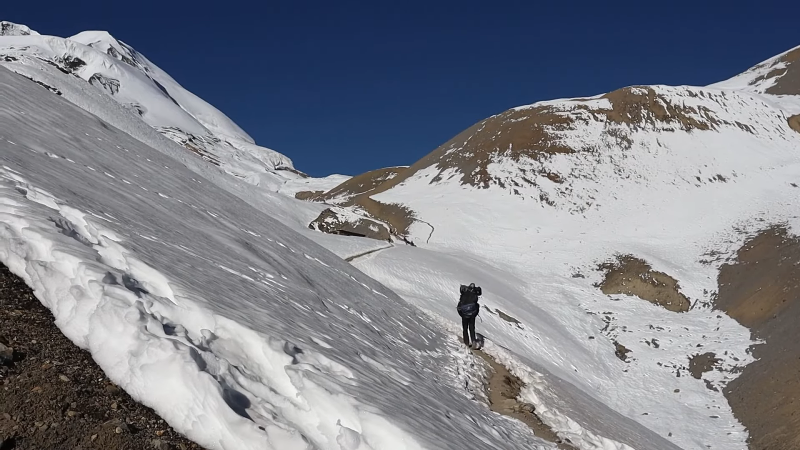
Porter Carrying Trekkers Luggage in Annapurna circuit trek
5.1 Route Options for Everest Base Camp
One popular route to reach Everest Base Camp is by taking a thrilling flight from Kathmandu to Lukla. The short and scenic flight offers breathtaking views of the Himalayas before landing on the challenging Tenzing-Hillary Airport, nestled amidst the mountains. Another option involves a picturesque drive from Kathmandu to Sallery, followed by a trek to Lukla. This overland journey showcases the diverse landscapes of Nepal, from lush valleys to quaint villages. For those seeking a more exclusive experience, sharing a helicopter flight from Kathmandu to Lukla provides a swift and luxurious alternative, granting passengers panoramic vistas of the majestic Everest region in a fraction of the time.
5.2 Route Options for Annapurna Circuit
There are varied routes to embark on the Annapurna Circuit trek. One common starting point is a scenic bus journey from Kathmandu to Besisahar, where trekkers can immerse themselves in the diverse landscapes of Nepal. Alternatively, a more private and expedited option involves hiring a jeep to travel directly from Kathmandu to Manang, bypassing Besisahar and reducing initial trekking days. This route provides a quicker transition to the higher-altitude sections of the Annapurna Circuit. Along the journey, trekkers encounter charming villages, terraced fields, and spectacular mountain views, making each route a unique adventure catering to different preferences and time constraints.
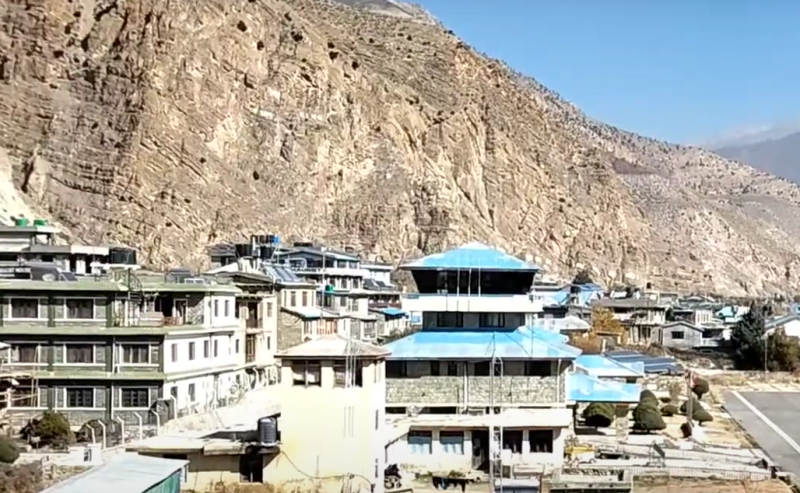
6.1 Teahouse Facilities at Everest Base Camp
Teahouse facilities at Everest Base Camp provide a unique blend of comfort and rustic charm, offering trekkers a cozy refuge amidst the breathtaking Himalayan landscape. While the journey to Everest Base Camp is marked by an abundance of Tea houses, it’s advisable to pre-book during the high season, especially in popular settlements like Lobuche and Gorakshep.
The Tea houses along the way are known for their warm hospitality and essential amenities. From Lukla to Namche Bazaar and beyond, these establishments cater to the needs of trekkers with comfortable lodging, hearty meals, and a chance to connect with fellow adventurers. The accommodations range from basic to relatively fancy, allowing trekkers to choose an option that suits their preferences and budget.
As you approach Lobuche and Gorakshep, the last two settlements before reaching Everest Base Camp, the availability of Tea houses may become more limited due to the increasing altitude and challenging terrain. In peak seasons, the demand for accommodations rises significantly, making pre-booking a prudent choice to secure a place to rest.
In the higher altitudes, the Tea houses/Lodges/Guest Houses may have fewer frills, but they compensate with an authentic mountain experience. Expect cozy common areas with wood-burning stoves, hearty meals to replenish your energy, and friendly locals eager to share their stories. The absence of luxury amenities is overshadowed by the awe-inspiring views and the camaraderie that develops among fellow trekkers.
Despite the challenges posed by the high-altitude terrain, the teahouse facilities at Everest Base Camp ensure that trekkers have a comfortable and memorable journey. The journey to the base camp is not just a physical adventure but a cultural experience, and the teahouses along the way contribute significantly to the overall charm of the trek.
6.2 Teahouse Facilities at Annapurna Circuit
The teahouse facilities along the Annapurna Circuit/Round Annapurna offer a warm and welcoming respite for trekkers exploring this iconic Himalayan trail. Nestled amidst breathtaking landscapes, these teahouses provide essential amenities for weary travelers. Typically constructed with traditional materials, they exude a rustic charm that enhances the overall trekking experience.
Visitors can expect basic but comfortable accommodations, hot meals, and a chance to mingle with fellow trekkers. The teahouses play a pivotal role in fostering a sense of camaraderie, creating a communal atmosphere where stories are shared and friendships forged. Additionally, many teahouses boast stunning views of the surrounding mountains, allowing guests to unwind and appreciate the natural beauty that surrounds them. The Annapurna Circuit’s teahouse facilities thus serve as vital waypoints, ensuring trekkers find both physical and cultural nourishment during their journey through this awe-inspiring region.
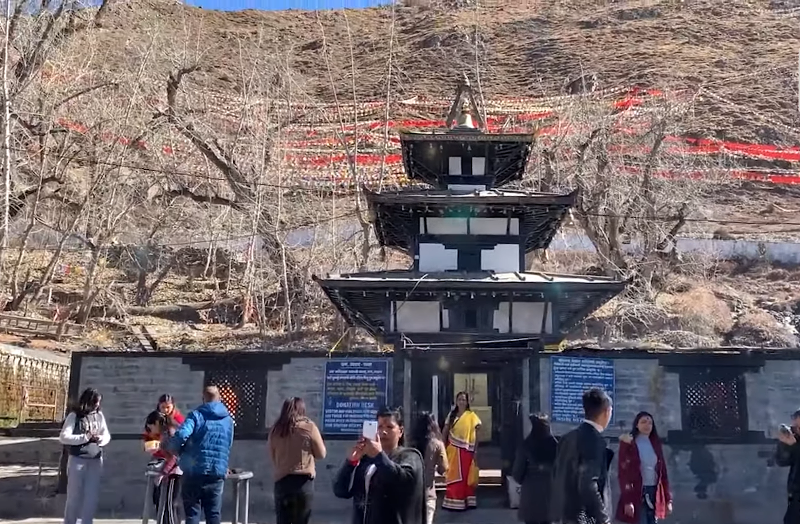
Muktinath Temple – A sacred Hindu temple located in the Mustang district of Nepal
7.1 Sherpa Culture at Everest Base Camp
The Sherpa culture at Everest Base Camp is deeply intertwined with the history and traditions of the region. As the indigenous people of the Himalayas, Sherpas have been an integral part of mountaineering expeditions, serving as guides, porters, and climbers. Their resilience and expertise in navigating the treacherous terrain have made them indispensable to the success of Everest ascents.
At Base Camp, Sherpas create a vibrant community that reflects their rich cultural heritage. Colorful prayer flags flutter in the wind, and traditional Sherpa music fills the air during ceremonies and celebrations. Shared meals and stories around the campfire strengthen the bonds among climbers and Sherpas, fostering a sense of camaraderie and mutual respect.
The Sherpa culture also emphasizes a deep connection to nature and spirituality. Monasteries in the vicinity play a significant role in the lives of Sherpas, who often participate in religious rituals and seek blessings before embarking on challenging climbs. This spiritual aspect adds a unique dimension to the Everest Base Camp experience, creating an environment where climbers and Sherpas collaborate not just as a team but as a community with shared values and traditions.
7.2 Cultural Diversity along Annapurna Circuit
The 14 days Annapurna Circuit Trekking, renowned for its breathtaking landscapes and diverse cultural tapestry, continues to be a sought-after trekking destination in Nepal. The route traverses through villages inhabited by distinct ethnic communities, including Gurung, Thakali, Magar, and Manange, offering a rich mosaic of cultural experiences. For the latest information on the region’s cultural diversity, it is advisable to consult travel advisory websites, connect with the Nepal Tourism Board, or engage with local trekking agencies. Ensuring a seamless and informed exploration of this iconic circuit involves staying abreast of travel updates, safety protocols, and any specific regulations in place.
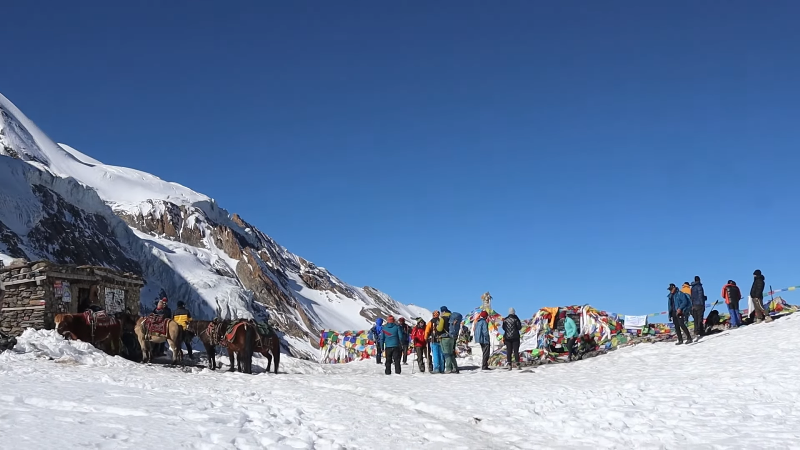
Thorong La Pass-nestled in the heart of the Annapurna Circuit Trek
8.1 Panoramic Views from Everest Base Camp and Kalapathar
From the vantage point of Everest Base Camp and Kalapathar, an awe-inspiring panorama unfolds, revealing the majestic peaks that dominate the Himalayan skyline. Towering giants like Mount Nuptse, Lhotse, and the legendary Everest command attention, their snow-capped summits reaching for the heavens. The formidable presence of Pumori and the iconic silhouette of Ama Dablam add to the grandeur, while Khumbutse and Changtse stand as silent sentinels. The ethereal beauty of the Khumbu Icefall and the expansive Khumbu Glacier sprawls below, etching a frozen path through the rugged terrain. This surreal landscape epitomizes the breathtaking allure of the Everest region, a testament to nature’s sublime artistry.
8.2 Scenic Views along Annapurna Circuit- Thorung la pass
Embark on a visual odyssey along the Annapurna Circuit, where nature’s magnificence unfolds at every turn, culminating in the breathtaking Thorung La Pass. As you ascend through the diverse landscapes, the snow-capped peaks of Annapurna, Dhaulagiri, and Nilgiri create an imposing backdrop against the cerulean sky. Verdant valleys, dotted with rhododendron forests, offer a vibrant contrast to the rugged, rocky terrain. Thorung La Pass stands as the pinnacle of this expedition, a lofty vantage point where panoramic vistas showcase the grandeur of the surrounding peaks, including Chulu West and Chulu East. The journey through this high-altitude haven is a symphony of natural beauty, an indelible tapestry etched into the soul of the adventurous traveler.
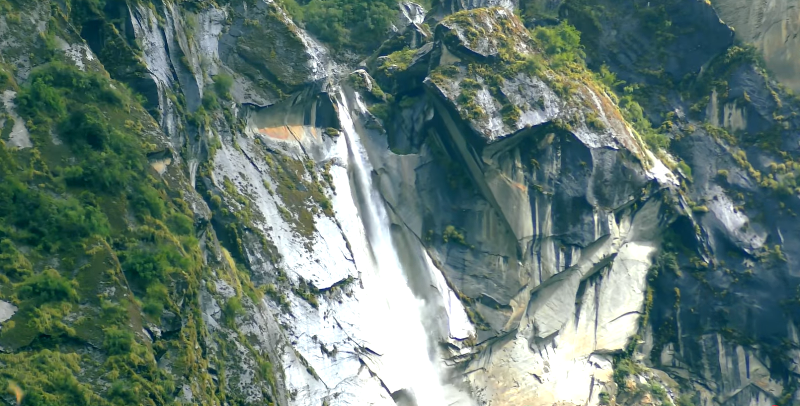
Water fall
9.1 Wildlife and Vegetation around Everest Base Camp
Nestled within the formidable embrace of the Himalayas, Everest Base Camp stands as a testament to both human ambition and the remarkable biodiversity that thrives in this extreme environment. The region surrounding this iconic base camp is a sanctuary for an array of wildlife and vegetation, offering a glimpse into the delicate balance of nature at high altitudes. The rugged terrain is home to Himalayan Thars, agile goats navigating precipitous slopes with grace, alongside the hardy Yaks that effortlessly traverse the challenging landscape. Amidst the austere beauty, the elusive Musk deer adds an element of intrigue to the alpine meadows, while tenacious alpine trees cling to the rocky expanses. This harmonious coexistence of resilient flora and fauna transforms Everest Base Camp into a captivating tableau of nature’s grandeur.
9.2 Biodiversity along Annapurna Circuit
The Annapurna Circuit, a renowned trekking route in the Himalayas, showcases a remarkable tapestry of biodiversity. As trekkers ascend through diverse elevations, ranging from lush subtropical forests to alpine meadows, they encounter a rich array of flora and fauna. The lower altitudes feature vibrant rhododendron forests, home to various bird species. Moving upwards, the landscape transitions to coniferous forests, harboring elusive wildlife like red pandas and Himalayan tahr. The circuit also encompasses unique ecosystems, such as the Kali Gandaki Gorge, where eagles soar above the world’s deepest river canyon. This trek not only offers awe-inspiring mountain vistas but also serves as a living testament to the biodiversity thriving in the Annapurna region.

Buddhist Memorial along the route of Annapurna Circuit trek
10.1 Weather Challenges at Everest Base Camp
Everest Base Camp, situated at an altitude of 17,600 feet (5,364 meters), experiences extreme and unpredictable weather conditions. The temperature can vary widely, ranging from mild and sunny during the day to bitterly cold at night. Daytime temperatures may hover around 10 to 15 degrees Celsius (50 to 59 degrees Fahrenheit), offering some respite, but the nights can plunge well below freezing, often reaching -10 degrees Celsius (14 degrees Fahrenheit) or lower.
The mornings at Everest Base Camp are characterized by crisp, frost-laden air, creating a breathtaking and serene atmosphere. As the day progresses, the sun’s rays penetrate the thin mountain air, providing a brief reprieve from the cold. However, by late afternoon, the temperature starts to drop rapidly, and the evenings usher in bone-chilling cold. These challenging weather conditions present a formidable obstacle for climbers and trekkers alike, demanding careful preparation and resilience in the face of Everest’s formidable climate.
10.2 Weather Conditions along Annapurna Circuit
The Annapurna Circuit, renowned for its stunning landscapes, presents diverse and demanding weather conditions. Daytime temperatures along the trek, which ranges in altitude from 2,600 feet (790 meters) to over 17,000 feet (5,181 meters), can vary widely. In lower regions, such as Besisahar, temperatures might be relatively mild, ranging from 15 to 25 degrees Celsius (59 to 77 degrees Fahrenheit). However, as trekkers ascend, the weather becomes more unpredictable, and temperatures can drop significantly, especially in the higher altitudes.
Mornings on the Annapurna Circuit often greet trekkers with crisp, cool air and clear skies, providing breathtaking views of the surrounding mountains. As the day progresses, temperatures become more moderate, making for comfortable trekking conditions. Nevertheless, evenings and nights can be quite chilly, with temperatures plummeting, sometimes reaching below freezing. This temperature fluctuation poses a challenge for trekkers, requiring them to adapt to the changing weather conditions and prepare for the cold nights along this iconic trekking route.
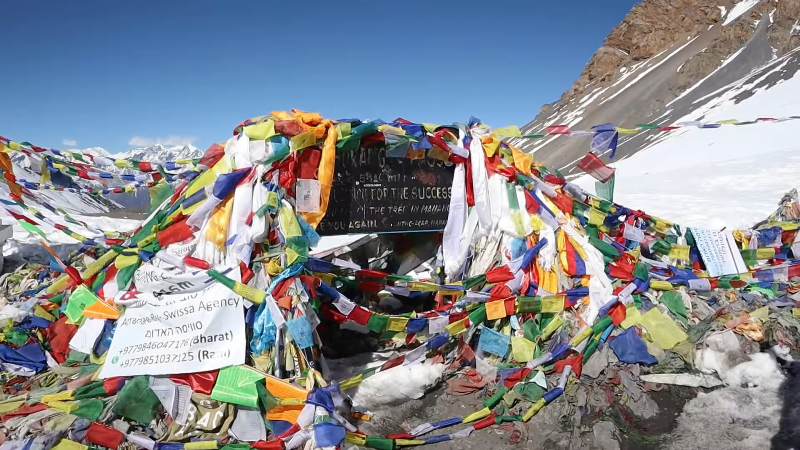
Thorang top- Annapurna Circuit trek
11.1 Budget Considerations for Everest Base Camp
For an Everest Base Camp trek budget ranging from 1100 to 1500 USD per person, costs hinge on various factors. Accommodation standards, the number of guides, and porters impact overall expenses. Budget-conscious options may involve shared lodges, while higher-end choices offer more comfort. Guide and porter services contribute to safety and convenience but vary in cost. Wise planning includes factoring in permits, meals, and unforeseen expenses. It’s crucial to balance budget constraints with essential services to ensure a fulfilling trekking experience in the awe-inspiring Himalayan landscape. Customizing services based on individual preferences will ultimately determine the final cost of this adventure.
11.2 Budget Considerations for Annapurna Circuit
The budget for the Annapurna Circuit trek can vary based on factors such as accommodation preferences, guide and porter services, permits, and individual spending habits. On average, a budget of 800 to 1200 USD per person is a reasonable estimate for a comprehensive trekking experience.
Accommodation options range from basic teahouses to more comfortable lodges and hotels. Teahouses are more budget-friendly but may offer fewer amenities, while upscale lodges provide greater comfort. The choice between a guide and porter or going independently affects costs. Guides offer navigation assistance and cultural insights, while porters ease the physical burden.
Permit fees are mandatory and include the Annapurna Conservation Area Permit (ACAP) and the Trekkers’ Information Management System (TIMS) card. These costs are essential for trekking in the region and contribute to conservation efforts.
Meals expenses also vary; while teahouses offer set menus, higher-end lodges may provide more diverse choices. Additional costs may include transportation to and from the trek starting point, travel insurance, and miscellaneous expenses.
To maximize the budget, it’s advisable to research and book accommodations in advance, negotiate guide and porter fees, and be mindful of personal spending. Flexibility in the itinerary allows for adjustments to unforeseen circumstances, contributing to a more enjoyable and cost-effective Annapurna Circuit trek.
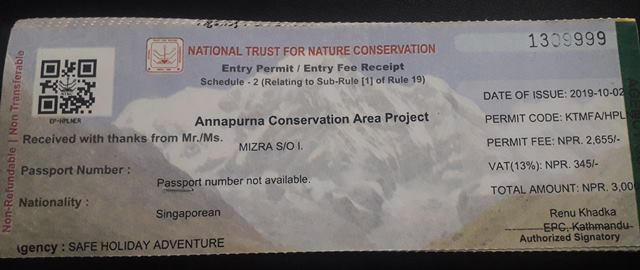
12.1 Permits Needed for Everest Base Camp
Trekking to Everest Base Camp requires obtaining two different permits: the Sagarmatha National Park Entry Permit and the Pasang Lhamu Rural Municipality Entry Permit.
Sagarmatha National Park Entry Permit:
Pasang Lhamu Rural Municipality Entry Permit:
In addition to the Sagarmatha National Park Entry Permit, trekkers are required to obtain the Pasang Lhamu Rural Municipality Entry Permit.
Important Points:
12.2 Permits Needed for Annapurna Circuit trek
For the Annapurna Circuit trek as of December 12, 2023, trekkers are required to obtain an Annapurna Conservation Area Permit (ACAP), costing 3000 NPR (approximately 26 USD) per person. This permit is crucial for entering and trekking in the Annapurna Conservation Area, a region known for its diverse flora and fauna. As of the mentioned date, the Trekker’s Information Management System (TIMS) card is not required for the Annapurna Circuit trek. Ensure you have the original passport with you during the permit application process. Keep in mind that trekking regulations may change, so it’s advisable to check for the latest updates from reliable sources before embarking on the trek.

Adventure Annapurna circuit trek/Round Annapurna trekking
13.1 Crowd Dynamics at Everest Base Camp
The Everest Base Camp (EBC) and Kalapathar region, nestled in the Himalayas, witness a unique confluence of adventurers and trekkers from around the globe. The crowd dynamics at EBC are shaped by a diverse mix of cultures, languages, and trekking expertise. As climbers prepare for their ascent to the world’s highest peak, the base camp transforms into a bustling hub of activity, with colorful tents dotting the landscape.
At Kalapathar, a vantage point offering breathtaking views of Everest, the crowd dynamics shift as trekkers gather to witness the sunrise illuminating the iconic summit. The camaraderie among climbers, shared stories around the campfires, and the collective pursuit of conquering Everest create an atmosphere of shared ambition and mutual respect, fostering a sense of community amidst the challenging mountain terrain.
13.2 Crowd Levels on the Annapurna Circuit
The Annapurna Circuit and the Everest Base Camp (EBC) trek stand out as two of Nepal’s premier trekking destinations, each offering a distinct adventure for enthusiasts. From my knowledge up until January 2022, one notable difference lies in the crowd levels experienced by trekkers on these iconic routes.
The Annapurna Circuit, renowned for its diverse landscapes, tends to be less crowded than the Everest Base Camp trek. Trekkers embarking on the Annapurna Circuit traverse through a variety of environments, including subtropical forests and high-altitude deserts. This diversity attracts those seeking a range of experiences, and the trek often provides opportunities for cultural immersion as it passes through numerous local villages.
In contrast, the Everest Base Camp trek, with its unparalleled views of Everest and other majestic peaks, has garnered immense popularity. Consequently, it tends to draw a higher number of trekkers. The teahouse infrastructure along the EBC trail is well-developed to accommodate the demand, offering a more established system for accommodation and services. The trek involves higher altitudes, and the ascent to Kala Patthar is a challenging yet rewarding highlight, contributing to the route’s allure.
It’s important to note that individual experiences may vary, and crowd levels can fluctuate with the seasons. The popularity of both treks has been on the rise, prompting efforts to manage their environmental impact and preserve the overall trekking experience. For the most current information on crowd levels, trekkers are advised to consult recent reports, forums, or local trekking agencies. Additionally, staying informed about permits, regulations, and the latest conditions is crucial for planning a successful and responsible trek in the breathtaking landscapes of Nepal.

While Trekking in Annapurna Circuit Trekking
14.1 Ideal Seasons for Everest Base Camp
The ideal seasons for trekking to Everest Base Camp are spring (March to May) and autumn (mid-September to end of November). During spring, the region blooms with vibrant rhododendron flowers, and clear skies offer breathtaking views of the Himalayas. The temperatures are mild, making it comfortable for trekking. In autumn, the weather is stable, with crisp, clear days and moderate temperatures, providing excellent visibility of the majestic peaks. These seasons also avoid the extreme cold of winter and the monsoon rains, ensuring a safer and more enjoyable trekking experience amidst the stunning landscapes of the Everest region.
14.2 Optimal Timing for Annapurna Circuit
The optimal timing for trekking the Annapurna Circuit is during the autumn season, from mid-September to end of November. During this period, the weather is generally stable, offering clear skies, mild temperatures, and stunning views of the Annapurna and Dhaulagiri mountain ranges. The days are dry, providing ideal trekking conditions, and the landscapes are adorned with vibrant colors as the fall foliage sets in. Spring (March to May) is also a suitable time, marked by blooming rhododendrons and a lush environment. These seasons avoid the monsoon rains and harsh winter conditions, ensuring a pleasant and rewarding trekking experience.
15.1 Choosing Between Everest Base Camp and Annapurna Circuit
The choice between Everest Base Camp and Annapurna Circuit depends on preferences and fitness levels. Everest offers iconic views of the world’s highest peak, while Annapurna Circuit boasts diverse landscapes, from lush forests to arid plateaus. Everest is challenging with higher altitudes, while Annapurna is longer but offers a more gradual ascent. Everest attracts more trekkers seeking the pinnacle of adventure, while Annapurna provides a cultural immersion with diverse ethnic communities. Consider the time of year, desired scenery, and trekking difficulty to make the best choice for a memorable Himalayan experience.
15.2 Personal Factors to Consider
When choosing between the Everest Base Camp and Annapurna Circuit treks, personal factors play a crucial role. Consider your fitness level, as Everest involves higher altitudes and Annapurna spans a longer distance. Personal preferences for landscapes, from Everest’s dramatic peaks to Annapurna’s diverse terrain, should guide your decision. Assess your trekking experience; Everest is more challenging, requiring acclimatization, while Annapurna offers a gradual ascent. Additionally, factor in your preferred level of solitude—Everest is more popular, while Annapurna provides a mix of cultural encounters. Weather and seasonal considerations, along with the time available for the trek, are also essential personal factors to weigh.
